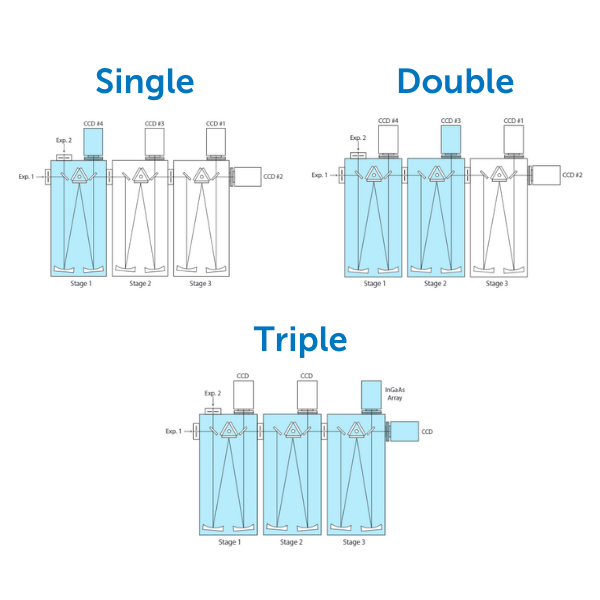

High-Resolution Double and Triple Spectrometers

TriVista operates at any wavelength from UV to IR and can work efficiently with multiple excitation wavelengths and tunable lasers. No edge or notch filters are needed for operation. In fact, TriVista’s performance is superior to common edge or notch filters having sharper and higher quality transmission edges, so you can observe spectral features closer to the instrument cut-off wavelength.
The TriVista can achieve higher resolution by combining the dispersion of all three spectrograph stages. This allows for the separation and resolve of any spectral features that are in very close wavelength vicinity.

Reveal more details in your spectra by combining the diffractive power of 2 or all 3 spectrograph stages. TriVista gives you up to 3x higher resolution compared to a single stage spectrometer. High resolution not only resolves more spectral features, but also allows you to track energy shifts and changes with much higher precision.

Exceptional stray light rejection means that you can observe spectral lines much closer to the excitation laser energy. Detect small energy shifts and low frequency Raman spectra as close as 5 cm-1 (0.62meV) from the excitation laser using CCD detection, or 2 cm-1 (0.25meV) using single channel PMT or APD detectors.

TriVista gives you maximum, operational flexibility to optimize the experimental setup to your measurement needs. Operate as single, double or triple spectrometer, in fact all TriVista stages can be operated independently from each other for simultaneous experiments. TriVista has 4 input and 4 signal ports that can accommodate CCDs, ICCDs, InGaAs, PMTs and many other detector options.

TriVista gratings drives are powered by AccuDrive technology that stands out due to its extremely high wavelength positioning precision and reproducibility. The rigid construction provides rock solid accuracy, repeatability, and stability. You can move between different wavelength and operational modes with confidence.

VistaControls graphical interface makes your experiment setup quick and easy. Full scan control and data acquisition, saving of many configurations for later use and quickly changing operational modes are some of the highlights of VistaControl.
The software supports Teledyne Princeton Instruments cameras and data acquisition systems and even has options for stage control and hyperspectral sample mapping.
| Wavelength Range | 200 – 2200 nm |
|---|---|
| Spectral Resolution | 0.13 cm-1 /0.16 μeV |
| Lowest Observable Energy Shift From Laser | ≈ 5 cm-1/0.62 meV (CCD), 2 cm-1/0.25 meV (PMT) |
| Entrance and Exit ports | Up to 4 input and 4 signal |
| Stray Light Rejection | As high as 10(-14) |